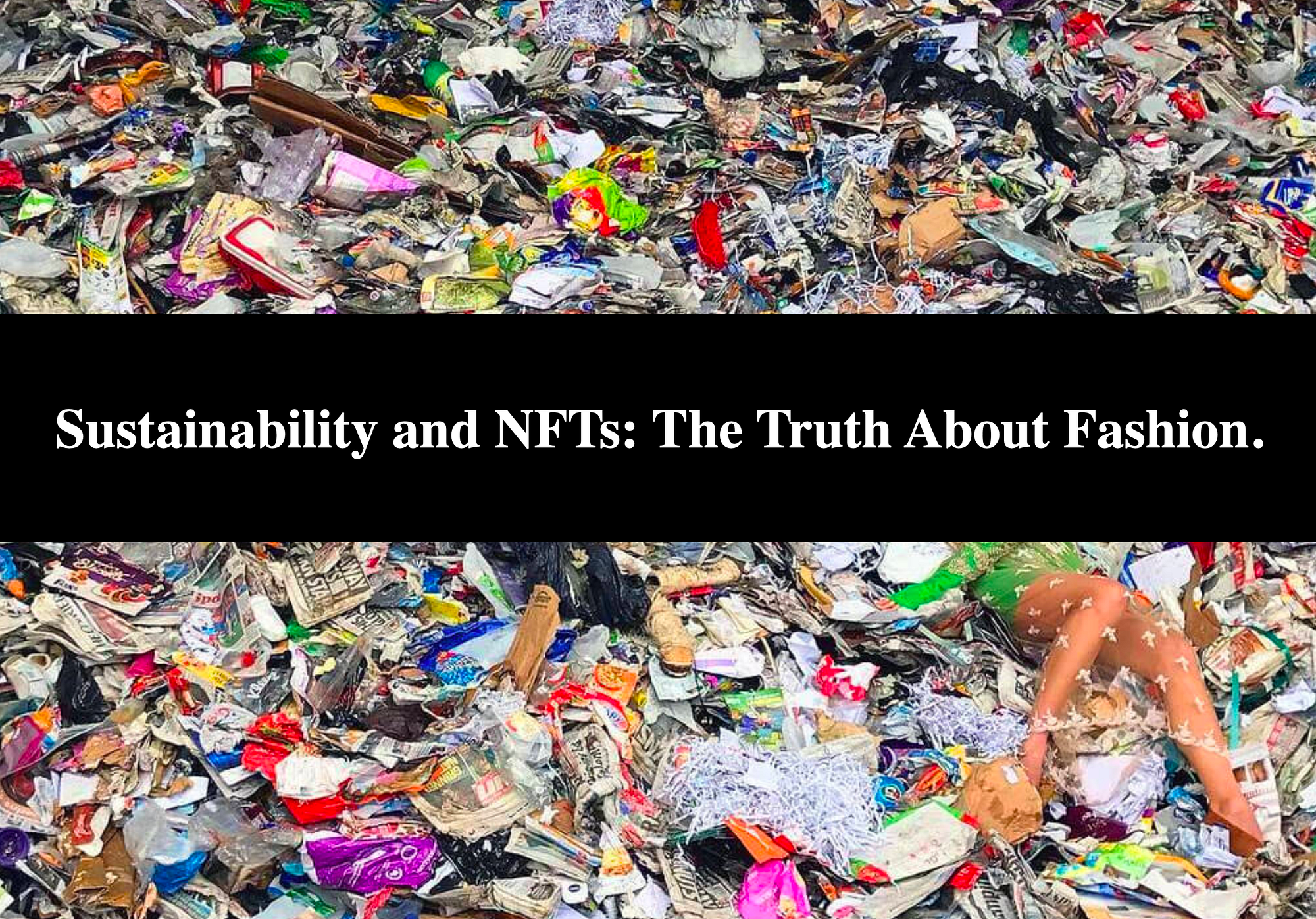
Emma-Jane MacKinnon-Lee
news
shop
feature
interviews
feed
links
DAILY IMAGE
HEY MR DJ!
ممكن معاك حقّ
¡En marcha!
Sustainability and NFTs. The Truth About Fashion
There has been much talk around the topics of NFTs and Sustainability over the past weeks, even more so as new market participants have entered the space and brought more activity to the ecosystem as a whole.
With our recent partnership with Matic (More to come on this soon) and our transition into the Ethereum Layer 2 community, it is most timely to publicly express DIGITALAX’s viewpoint and position on NFTs, Sustainability and everything alike.
First, let’s start at the core of DIGITALAX: Fashion.
From an environmental stance, the traditional fashion industry causes some of the most devastating effects globally, where it is only second to the oil industry in terms of pollution damage. The generated waste across the entire supply chain from textile manufacture, fabrication dying, transportation, logistics, air-conditioning and heating for physical store fronts, e-commerce shipment returns, oil based materials ending up in landfills… (the list is endless) is astounding. Fun Fact: H&M in 2018 disclosed a $4.3bn unsold stockpile that was just trashed and discarded by them.
With the industry pushing forward rapidly around ‘fast fashion’ and pumping out new designs and product lines at an ever increasing pace in order to keep up with consumer demand and the desire for a never ending unique selection of different clothing, the injection of truly impactful sustainable practices are not part of the equation.
This is literally why the digital fashion industry first spawned— to reduce wasteful practices across the supply chain. Digital fashion 3D software applications allowed designers a rapid prototyping process upgrade that also generates almost zero waste relative to the traditional counterpart.
The future of mass Digital fashion adoption will completely upend current wasteful industry practices around manufacturing, material dyeing and ‘fast fashion’ production cycles. Time to market is much more streamlined and allows for flexibility in reaction time i.e. being able to quickly distribute more designs of a certain product that becomes hugely successful overnight without requiring any coordination across a clunky supply chain.
Digital fashion distribution through NFTs is significantly more empowering because directly returning financial power to the hands of creators and the masses means individual agency in energy and consumer goods purchasing. There is not a single policy that will have a greater impact on sustainability.
The conversations being brought up around the negative impact of NFTs on the environment and future sustainability of the planet address the topic in a clumsy, ill-informed and often disingenuous manner.
Most of the activity on the Ethereum network actually has nothing to do with NFTs. NFTs still form only one subset of the broader crypto and blockchain ecosystem, and broader economic activity. The idea that we should grind human activity in order to save the environment is fundamentally flawed, and, we don’t see the people calling for this the loudest cutting their social media usage, purchase of traditional fashion items, jet travel, cloud usage, or other modern human amenities. And, even if they did lead by their example, debates over whose morality is more virtuous do next to nothing to solve the real likely catastrophic environmental challenges that we all face.
The point is, it is not about virtue posturing. It is about cutting the bullshit and solving the issues in a way that will actually bring tangible results. We are not here to cherry pick data and diminish the value of unseen creators finally gaining recognition, influence and a path to their own sustainability.
Part of this is also just what comes with new radical innovation. It is the growing pains of the technology. We see this time and again— is it really fair to say that Henry Ford’s invention of the vehicle was more damaging than helpful… it is ridiculous to think that we have stagnated. Look at all of the implementable innovation around electric vehicles. This won’t be stopping anytime soon.
Ethereum and the majority of the blockchain industry are herding towards Layer 2 solutions, that are now live, and also phasing out PoW systems. In saying this, even Bitcoin, as a core PoW consensus, has its miners pushing the adoption curve on renewable sources of energy, and at the same time, directly transforming carbon emissions into financial incentives.
DIGITALAX’s migration to Matic was stemmed not only out of our support for more efficient network solutions, but also, our emphasis on the importance of mass adoption of NFTs that actually have tangible application and utility. This in itself is a huge leap and a factor that deserve’s much more attention in the general market. What is really the point of driving market activity and demand if you can’t concentrate this into an ecosystem that then is able to generate value for all its core participants in a sustainable manner.
This is what we are doing. And, we have set out to be the underlying infrastructure and protocol layer for everyone who truly cares about the intersection of sustainable innovation and human economic flourishing. In other words, this is a textile monetary system.
We are a platform for creators servicing mindful consumers. And for that we are responsible stewards of trust.
With our recent partnership with Matic (More to come on this soon) and our transition into the Ethereum Layer 2 community, it is most timely to publicly express DIGITALAX’s viewpoint and position on NFTs, Sustainability and everything alike.
First, let’s start at the core of DIGITALAX: Fashion.
From an environmental stance, the traditional fashion industry causes some of the most devastating effects globally, where it is only second to the oil industry in terms of pollution damage. The generated waste across the entire supply chain from textile manufacture, fabrication dying, transportation, logistics, air-conditioning and heating for physical store fronts, e-commerce shipment returns, oil based materials ending up in landfills… (the list is endless) is astounding. Fun Fact: H&M in 2018 disclosed a $4.3bn unsold stockpile that was just trashed and discarded by them.
With the industry pushing forward rapidly around ‘fast fashion’ and pumping out new designs and product lines at an ever increasing pace in order to keep up with consumer demand and the desire for a never ending unique selection of different clothing, the injection of truly impactful sustainable practices are not part of the equation.
This is literally why the digital fashion industry first spawned— to reduce wasteful practices across the supply chain. Digital fashion 3D software applications allowed designers a rapid prototyping process upgrade that also generates almost zero waste relative to the traditional counterpart.
The future of mass Digital fashion adoption will completely upend current wasteful industry practices around manufacturing, material dyeing and ‘fast fashion’ production cycles. Time to market is much more streamlined and allows for flexibility in reaction time i.e. being able to quickly distribute more designs of a certain product that becomes hugely successful overnight without requiring any coordination across a clunky supply chain.
Digital fashion distribution through NFTs is significantly more empowering because directly returning financial power to the hands of creators and the masses means individual agency in energy and consumer goods purchasing. There is not a single policy that will have a greater impact on sustainability.
The conversations being brought up around the negative impact of NFTs on the environment and future sustainability of the planet address the topic in a clumsy, ill-informed and often disingenuous manner.
Most of the activity on the Ethereum network actually has nothing to do with NFTs. NFTs still form only one subset of the broader crypto and blockchain ecosystem, and broader economic activity. The idea that we should grind human activity in order to save the environment is fundamentally flawed, and, we don’t see the people calling for this the loudest cutting their social media usage, purchase of traditional fashion items, jet travel, cloud usage, or other modern human amenities. And, even if they did lead by their example, debates over whose morality is more virtuous do next to nothing to solve the real likely catastrophic environmental challenges that we all face.
The point is, it is not about virtue posturing. It is about cutting the bullshit and solving the issues in a way that will actually bring tangible results. We are not here to cherry pick data and diminish the value of unseen creators finally gaining recognition, influence and a path to their own sustainability.
Part of this is also just what comes with new radical innovation. It is the growing pains of the technology. We see this time and again— is it really fair to say that Henry Ford’s invention of the vehicle was more damaging than helpful… it is ridiculous to think that we have stagnated. Look at all of the implementable innovation around electric vehicles. This won’t be stopping anytime soon.
Ethereum and the majority of the blockchain industry are herding towards Layer 2 solutions, that are now live, and also phasing out PoW systems. In saying this, even Bitcoin, as a core PoW consensus, has its miners pushing the adoption curve on renewable sources of energy, and at the same time, directly transforming carbon emissions into financial incentives.
DIGITALAX’s migration to Matic was stemmed not only out of our support for more efficient network solutions, but also, our emphasis on the importance of mass adoption of NFTs that actually have tangible application and utility. This in itself is a huge leap and a factor that deserve’s much more attention in the general market. What is really the point of driving market activity and demand if you can’t concentrate this into an ecosystem that then is able to generate value for all its core participants in a sustainable manner.
This is what we are doing. And, we have set out to be the underlying infrastructure and protocol layer for everyone who truly cares about the intersection of sustainable innovation and human economic flourishing. In other words, this is a textile monetary system.
We are a platform for creators servicing mindful consumers. And for that we are responsible stewards of trust.
NEWS OF NEW
JOIN THE MAILING LIST

ENTREVISTA - 2025
DIGITALAX + FASHION ON ETHEREUM
Since 2019, I've been building, full-time, factorial combinators of the principles of web3 that scale through greater use — self sovereignty, decentralisation and open access.
שלום I'm now based in Uruguay. Connect on Lens! שלום





Got a problem with that? Speak to the agents…